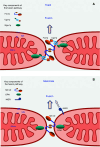Regulation of mitochondrial dynamics: convergences and divergences between yeast and vertebrates
- PMID: 22806564
- PMCID: PMC3578726
- DOI: 10.1007/s00018-012-1066-6
Regulation of mitochondrial dynamics: convergences and divergences between yeast and vertebrates
Abstract
In eukaryotic cells, the shape of mitochondria can be tuned to various physiological conditions by a balance of fusion and fission processes termed mitochondrial dynamics. Mitochondrial dynamics controls not only the morphology but also the function of mitochondria, and therefore is crucial in many aspects of a cell's life. Consequently, dysfunction of mitochondrial dynamics has been implicated in a variety of human diseases including cancer. Several proteins important for mitochondrial fusion and fission have been discovered over the past decade. However, there is emerging evidence that there are as yet unidentified proteins important for these processes and that the fusion/fission machinery is not completely conserved between yeast and vertebrates. The recent characterization of several mammalian proteins important for the process that were not conserved in yeast, may indicate that the molecular mechanisms regulating and controlling the morphology and function of mitochondria are more elaborate and complex in vertebrates. This difference could possibly be a consequence of different needs in the different cell types of multicellular organisms. Here, we review recent advances in the field of mitochondrial dynamics. We highlight and discuss the mechanisms regulating recruitment of cytosolic Drp1 to the mitochondrial outer membrane by Fis1, Mff, and MIEF1 in mammals and the divergences in regulation of mitochondrial dynamics between yeast and vertebrates.
Figures







References
Publication types
MeSH terms
Substances
LinkOut - more resources
Full Text Sources
Molecular Biology Databases
Miscellaneous

